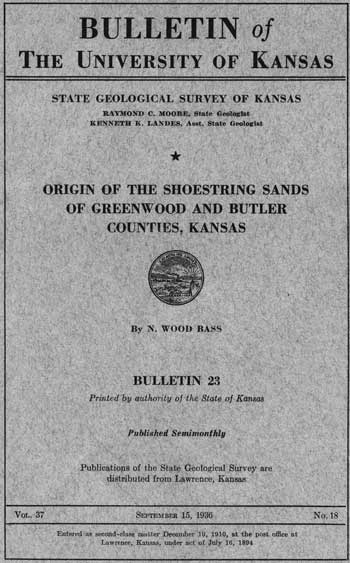Origin of the Shoestring Sands of Greenwood and Butler Counties, Kansas
By N. Wood Bass

Investigation conducted under a cooperative agreement between the United States Geological Survey and the State Geological Survey of Kansas. Originally published in 1936 as Kansas Geological Survey Bulletin 23. This is, in general, the original text as published. The information has not been updated.
Abstract
High-grade oil, occurring in the shoestring sands in the Cherokee shale of Pennsylvanian age, has been produced for fifteen years in Greenwood, Butler and adjacent counties, in southeast central Kansas. The shoestring sand bodies are lens-shaped and elongated, and range in thickness from 50 to more than 100 feet, in width from 1/2 to 1 1/2 miles, and in length from 1 to 7 miles; they are systematically arranged approximately end to end and form several systems, or trends, each 25 to 45 or more miles long. Two systems with parallel trends in a northeast-southwest direction are known locally as the main trends; two others, also approximately parallel, known as cross trends, extend northwest-southeast. A fifth system having a north-south trend is 35 miles long.
The area in Greenwood, Butler and adjacent counties is especially appropriate for a study of such sand bodies, because several of the shoestring sand systems have been completely developed by oil wells throughout their lengths of 25 to 45 miles, and because the oil wells, together with hundreds of dry holes, have closely defined the outlines and distribution of the sand bodies. There are, however, some undrilled areas of considerable extent wherein the sand systems may be present. The methods here used for studying the sands, and the conclusions obtained from the studies, are believed to be applicable not only to undeveloped areas in Kansas but to many areas in Oklahoma and Texas, and probably elsewhere.
The composition, shapes and sizes of the sand grains were studied and compared with those of sand grains in modern sands of known origin, in the channel sandstone deposits of Pennsylvanian age exposed in Missouri, and in the sandstone lenses in the Cherokee shale exposed in eastern Kansas and northeastern Oklahoma. Most of the shoestring sand lenses are composed of very fine to fine grains of subangular quartz, with minor amounts of feldspar and mica; silt and clay comprise 15 to 30 percent of the material. Coarse and very coarse sand, composed largely of well-rounded quartz grains, characterize the sand bodies in a portion of one cross trend.
The shapes of the sand bodies were studied by means of scores of cross sections constructed from well logs, and by block diagrams of the individual sand bodies, a few of which are reproduced here. The studies show that the sand bodies are flat-bottomed lenses with convex tops, and that the individual lenses are separated by narrow stretches of country barren of sand. The cross sections show also that the sands of one system are somewhat higher stratigraphically than those of another. A map of Greenwood, Butler and adjacent counties showing the distribution of the shoestring sands, reveals that each sand body is arranged en echelon with respect to the adjacent bodies, a feature which is believed to be highly significant in determining the origin of the sand lenses.
The distribution of the shoestring sands indicates clearly that they are either stream channel deposits or offshore bars. The high content of silt and clay suggests that the sands were not formed as offshore bars, but may represent stream deposits; on the other hand, the well-rounded, coarse sand found in parts of the area is more characteristic of offshore bar sand. The cross sections, the block diagrams, and the maps showing the distribution of the sand indicate that the sand bodies are similar in outline and form to modern offshore bars and are dissimilar to stream channel deposits. The conclusion from available evidence is that the sand bodies are offshore bars that accumulated in a broad bay on the western shore of the Cherokee sea. Most of the sand bodies are included in two systems that were deposited at slightly different times; each system is composed of a main trend, and a cross trend, as referred to locally.
During the last of the two stages of bar building the newly formed shoreline cut diagonally across the old shore line and a part of the earlier offshore bar system lay seaward below the surface of the water. The waves and currents that built the second system of bars partly destroyed the seaward portions of the sand bodies of the older system. The probable distribution of land and sea during the time the offshore bars were being deposited is illustrated by maps of eastern Kansas. There are many areas in the region that may contain undiscovered oil fields.
Kansas Geological Survey, Geology
Placed on web May 3, 2011; originally published Sept. 1936.
Comments to webadmin@kgs.ku.edu
The URL for this page is http://www.kgs.ku.edu/Publications/Bulletins/23/index.html